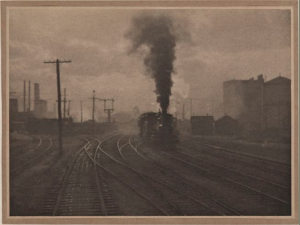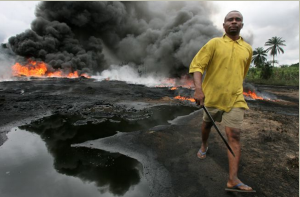
![]() The atmosphere surrounding our planet is an ocean of gases, water vapor and dust. It acts as a giant filter, keeping out harmful ultraviolet radiation, while letting in the warmth of the sun. Over the last two centuries, industrial pollution has become an increasingly serious problem, resulting in adverse effects on humans and the ecosystem
The atmosphere surrounding our planet is an ocean of gases, water vapor and dust. It acts as a giant filter, keeping out harmful ultraviolet radiation, while letting in the warmth of the sun. Over the last two centuries, industrial pollution has become an increasingly serious problem, resulting in adverse effects on humans and the ecosystem
Alfred Stieglitz, however, was most likely not thinking of the negative effects of the coal-burning steam engine when he made his photograph The Hand of Man in 1902. When he reprinted the negative as a gelatin silver print after 1920, he placed even greater emphasis on the gleaming steel tracks and lightened the sky to make the dark smoke stand out more. As a  photogravure printed with dark sepia ink on cream-colored paper, the image is softer and moodier.
photogravure printed with dark sepia ink on cream-colored paper, the image is softer and moodier.
Subjects that praised modern industry and architecture caught the eye of many photographers in the early twentieth century, among them Stieglitz and his compatriot Edward Steichen, as well as Charles Sheeler, Edward Weston and Margaret Bourke-White, to name a few. Stieglitz made numerous photographs of the rising skyline of New York City, as well as scenes shot from the back window of the gallery 291 and from the thirtieth story of the Shelton Hotel, where he lived with his wife, Georgia O’Keeffe.
The title The Hand of Man celebrated the gritty beauty of the modern railroad train and tracks of the Long Island City train yards; it also referred to the hand-made photographic technique of photogravure used to make this print. The image was included in the inaugural issue of Stieglitz’s magazine Camera Work, which was a platform for the consideration of photography as a fine art during the Industrial Age.

Instead of photographing a cloudscape in a seemingly unspoiled wilderness, as Ansel Adams and Brett Weston would in numerous photographs, Stieglitz chose to focus on the dark man-made cloud rising from the steam engine. In doing so, he looked back to the railroad photographs produced by nineteenth-century frontier photographers such as A.J. Russell, and forward to photographers such as the Nigerian artist, George Osodi, who has photographed the detrimental effects of industrial pollution.